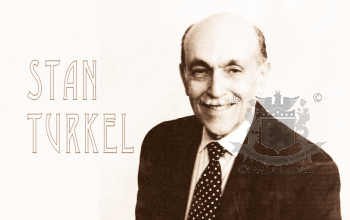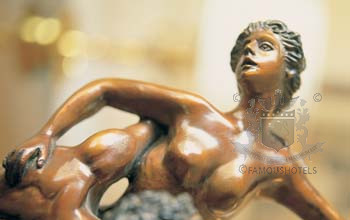Hotel Marseilles: A Beaux-Arts Beauty Since 1905
( words)
By Stanley Turkel, MHS, ISHC
On October 2, 1990, the Landmarks Preservation Commission designated the Hotel Marseilles as a landmark. It is among the most prominent of the grand apartment hotels erected on the upper west side.
The Beaux-Arts building was constructed in 1902-1905 to the designs of architect Harry Allan Jacobs at a time when construction of the new Interborough Rapid Transit (IRT) subway line along Broadway included a station at West 103rd Street. The 103rd Street Station was one of fourteen subway stations to open in 1904 under Broadway from West 50th to West 157th Street.
A distinguished example of the wave of large- scale hotel construction that followed the passage of the N.Y. Tenement House Law of 1901, the Hotel Marseilles, along with the Astor and the Ansonia Hotels, was one of the grand apartment hotels.
The Hotel Marseilles, clad in brick with limestone, wrought-iron and terra-cotta trim and crowned with a sloping mansard roof, illustrates the rise of the modern French style in commercial and hotel architecture. The popularity of this style in the United States resulted from the increase of American architects attending the Ecole des Beaux-Arts in Paris at the end of the nineteenth century. (More than 350 were enrolled between 1890 and 1910.)
The Marseilles was built by the Netherlands Construction Company (J. Arthur Pinchbeck, president). Henry Allan Jacobs, architect of the Marseilles, was born and educated in New York City and began his architectural training at the Columbia School of Mines. After graduating in 1894, he continued his studies in Paris at the Ecole des Beaux- Arts and was awarded the Prix de Rome. A notable example of his early work is the Seville Hotel (1901-04) at Madison Avenue and 29th Street.
In addition to hotels, Jacob’s practice focused on the design of elegant residences. An important early example of this period in his career is the Charles Guggenheimer residence at 129 East 73rd Street (1907) in the Upper East Side Historic District. This neo-Italian Reneissance style townhouse, faced in limestone, served as a model for many of his later commissions. Other commission earned Jacobs wide recognition, including a new façade design for the house of philanthropist R. Fulton Cutting at 22 East 67th Street (1908) and a residence for theater producer Martin Beck at 13 East 67 Street (1921), both in the Upper East Side Historic District. Later in his career Jacobs designed the neo-Italian Renaissance style Andrew Freedman Home (1924-25) at 1125 Grand Concourse in the Bronx, a collaboration with architect Joseph H. Freedlander (1870-1943), a specialist in institutional design. Jacobs returned to hotel design in 1927 with the neo-Renaissance style Hotel Elysee located at 54-60 East 54th Street.
Jacob’s career, spanning the first quarter of the twentieth century, embraced a wide variety of styles, including Beaux-Arts, neo-Federal, and neo-Renaissance. Undoubtedly the high quality of his work and the prominent social standing of some of his clients contributed to the success of his practice.
The eleven-story Marseilles apartment hotel building is U-shaped in plan, with a courtyard opening to the south. Faced in stone and brick with wrought-iron and terra-cotta details, the façade is a rich Beaux-Arts composition retaining much of its original appearance.
Faced in stone, stories one through three on the Broadway façade are articulated by seven bays each. Stories four through seven are faced in brick with glazed headers. The first story retains its original openings for storefronts flanked by stone piers and crowned by rectangular spaces designed to hold signage.
The West 103rd Street façade, nine bays wide, continues the same overall design and articulation of detail as the Broadway façade. The stone base of the building decreases in height at the western end to conform to the sloping site. An entrance, located five bays from the eastern end, is topped by a transom faced with original ironwork and is flanked by pairs of large banded and fluted Tuscan columns on pedestals with pilasters behind. These support an entablature featuring garlands, mutules, modillions, and a stone balustrade. Above the entrance is a large cartouche embellished with swags and a mask. The entrance is flanked by an areaway enclosed by wrought-iron railings and stone posts. The large window openings flanking the entrance are arched and contain stone balustrades at the base supporting square-headed windows topped by oculi. The bay above the entrance has a paired window flanked by two slit windows separated by thick modillions; this pattern continues up to the ninth story.
The western elevation, visible above the neighboring building on West 103rd Street, is faced in brown brick with three window openings per story; the smaller center opening has been sealed with red brick. Light-colored brick bandcourses, marking returns of significant features of the West 103rd Street façade, have been obscured by gray paint. A painted sign reading “Marseille,” executed in script, is located on the wall.
The Hotel Marseilles survives largely intact as a luxury residential apartment building. In recent years, the two southern bays of the first story of the Broadway faced have been altered for a restaurant with the entrances surrounded in concrete. The windows, tripartite single-pane with transoms and one-over-one double-hung, are aluminum sash. Aluminum spandrel panels have been installed in the double-height bays at the ninth story. A projecting aluminum and glass vestibule has been installed at the main entrance on West 103rd Street. A new metal door has been installed in the areaway of the west façade; other basement openings to the west of the entrance have been sealed with concrete panels. The wrought iron of the areaway fence has been replaced; the stone balustrade in the window opening to the east of the entrance has been removed. The mansard roof that crowns the building has been resurfaced with asphalt shingles, and in recent years it has been pierced by a row of double-hung windows at the eleventh story.
Great Gift Idea for the Holidays
Stanley Turkel, MHS, ISHC has just published “Great American Hoteliers: Pioneers of the Hotel Industry.” It contains 359 pages, 25 illustrations and 16 chapters devoted to each of the following pioneers: John McEntee Bowman, Carl Graham Fisher, Henry Morrison Flagler, John Q. Hammons, Frederick Henry Harvey, Ernest Henderson, Conrad Nicholson Hilton, Howard Dearing Johnson, J. Willard Marriott, Kanjibhai Patel, Henry Bradley Plant, George Mortimer Pullman, A.M. Sonnabend, Ellsworth Milton Statler, Juan Terry Trippe and Kemmons Wilson. It also has a foreword by Stephen Rushmore, preface, introduction, bibliography and index.??
Visit //greatamericanhoteliers.com










